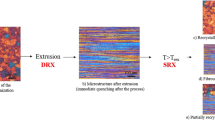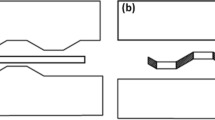Abstract
A mathematical model using the commercial finite element method software package DEFORM 2D was developed and validated to model extrusion of AA3xxx aluminum alloys rods. Using a simple approach based on the initial grain size and material flow during extrusion, the deformed grain thickness during and after extrusion could be predicted with good accuracy. The model predicted deformed grain thickness, which, in conjunction with knowledge of the subgrain size during deformation, was used to predict the occurrence of the creation of a different microstructure near the surface of the extrudate as compared to the centre. The model predicts with good accuracy the deformed grain thickness and how it varies spatially both through the diameter of the extruded rod and along its length. The model predicts that the deformed grain thickness decreases dramatically from the center to the surface of the extrudate and how this is impacted by the extrusion ratio. Applying a cutoff value of the subgrain size, allows the prediction of the critical radius beyond which a more granular microstructure occurs at the surface. Optical microscopy and orientation imaging microscopy of the extruded AA3xxx rods were used to validate the model predictions of the deformed grain structure, both in terms of the grain thickness and the critical radius, beyond which the microstructure becomes more granular close to the rod surface.



















Similar content being viewed by others
Notes
HKL Channel 5 is a trademark of Oxford Instruments plc.
F. J. Humphreys, the University of Manchester.
Scientific Forming Technologies Corporation (SFTC).
References
Humphreys FJ, Harthely M (2004) Recrystallization and Related Annealing Phenomena, 2nd edn. Elsevier, Amsterdam
H. J. McQueen, E. Evangelista and M. E. Kassner, Zeitschrift fur Metallkunde, vol. 82, no. 5, pp. 336-45, 1991.
M. E. Kassner, M. M. Myshlyaev and H. J. McQueen, Mater. Sci. Eng., A, vol. A108, pp. 45-61, 1989.
H. J. McQueen, O. Knustad, N. Ryum and J. K. Solberg, Scripta Metallurgica, vol. 19, pp. 73-78, 1985.
McQueen HJ, Spigarelli S, Kassner ME, Evangelista E (2011) Hot Deformation and Processing of Aluminum Alloys. Taylor & Francis Group, Boca Raton, FL
M. R. Drury and F. J. Humphreys, Acta Metallurgica, vol. 34, no. 11, p. 2259–271, 1986.
J. K. Solberg, H. J. McQueen, N. Ryum and E. Nes, Philos Mag, vol. 60, no. 4, pp. 447-71, 1989.
H.J. McQueen: Hot Deformation of Aluminum Alloys Proceedings, 1991, pp. 31–54.
T. Furu, O. Sodahl, E. Nes, L. Hanssen and O. Lohne, Mater. Sci. Forum., Vols. 157-162, pp. 1197-204, 1994.
W. H. Van Geertruyden, H. M. Brown, W. Z. Misiolek and P. T. Wang, Metall. Mater. Trans. A, vol. 36A, pp. 1049-56, 2005.
C. Poletti, M. Rodriguez-Hortalá, M. Hauser and C. Sommitsch, Mater. Sci. Eng., A, vol. 528, p. 2423–30, 2011.
W. H. Van Geertruyden, W. Z. Misiolek and P. T. Wang, J. Mater. Sci., vol. 40, pp. 3861-863, 2005.
Y. Mahmoodkhani, M.A. Wells, L. Grajales, W.J. Poole, and N. Parson: ICAA13, Pittsburgh, PA, 2012.
Y. Mahmoodkhani, M. A. Wells, N. Parson and W. J. Poole, Journal of Materials Processing Technology, vol. 214, no. 3, p. 688–700, 2014.
Y. Geng: Master’s Thesis, The University of British Columbia, Vancouver, 2011.
Humphreys FJ (2000) VMAP is a Suite of Programs Developed for Quantitative Analysis of the EBSD Data Generated by the HKL Channel Acquisition System. Wiley, New York
L.M. Grajales: Master’s Thesis, The University of British Columbia, Vancouver, 2013.
J. Chen, W. Poole, and N. Parson: ICAA 2014, Trondheim, Norway, 2014.
Y. Mahmoodkhani, Mathematical Modelling of the Material Flow and Microstructural Evolution During the Extrusion of AA3003 Aluminum Alloy,” University of Waterloo, Waterloo ON, 2013.
Acknowledgments
The authors would like to gratefully acknowledge the financial support of NSERC (Canada) and Rio Tinto Alcan (RTA) and thank Dr. Joseph D. Robson and Liam Dwyer for helping on EBSD microscopy, and Prof. F. J. Humphreys for permission to use the VMAP software.
Author information
Authors and Affiliations
Corresponding author
Additional information
Manuscript submitted on July 3, 2014.
Rights and permissions
About this article
Cite this article
Mahmoodkhani, Y., Wells, M.A., Poole, W.J. et al. The Development of Grain Structure During Axisymmetric Extrusion of AA3003 Aluminum Alloys. Metall Mater Trans A 46, 5920–5932 (2015). https://doi.org/10.1007/s11661-015-3168-x
Published:
Issue Date:
DOI: https://doi.org/10.1007/s11661-015-3168-x




